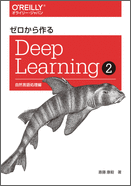Kerasメモ(seq2seqで足し算)
以下の書籍を参考に、seq2seqを使った足し算を試してみる。

O'Reilly Japan - ゼロから作るDeep Learning ❷
データの長さは固定で「12」、値がない部分はブランクで埋める。
- 式部分の長さ : 「7」固定
- 答え部分の長さ : 「5」固定(イコールにあたる"_"含む)
データ例(addition.txt)
16+75 _91 52+607 _659 75+22 _97 63+22 _85 795+3 _798 706+796_1502 ...
サンプル数は全体で「50,000」、学習用に90%、残り10%を検証用に分割する。
出現する文字は、数字の「0から9」、プラス記号、ブランク、アンダーバーの13種類。
「input_dim」が「13」、「output_dim」が「16」のEmbeddingレイヤを通して特徴ベクトルに変換する。
今回、Encoder側とDecoder側とでEmbeddingレイヤを「それぞれ持つ」パターンと「共有する」パターンを試してみる。
モデルはKerasで書き直した。
Embeddingレイヤをそれぞれ持つパターン
学習モデル

推論モデル

Embeddingレイヤを共有するパターン
学習モデル

推論モデル

学習時のパラメータを以下のとおり設定。
batch_size = 128 # Batch size for training. epochs = 20 # Number of epochs to train for. train_model.compile(optimizer='adam', loss='categorical_crossentropy')
学習後、検証データを推論モデルに渡した結果の一部。2番目は誤りパターン。
Input sentence: ['3', '6', '7', '+', '5', '5', ' '] Decoded sentence: ['4', '2', '2', ' '] label sentence: ['4', '2', '2', ' '] - Input sentence: ['6', '0', '0', '+', '2', '5', '7'] Decoded sentence: ['8', '6', '7', ' '] label sentence: ['8', '5', '7', ' '] - Input sentence: ['7', '6', '1', '+', '2', '9', '2'] Decoded sentence: ['1', '0', '5', '3'] label sentence: ['1', '0', '5', '3'] -
今回、3種類のモデルを作成した。
- 1番目のモデル : EmbeddingレイヤをEncoder / Decoderでそれぞれ保持、インプットは順方向
- 2番目のモデル : EmbeddingレイヤをEncoder / Decoderでそれぞれ保持、インプットは逆方向
- 3番目のモデル : EmbeddingレイヤをEncoder / Decoderで共有、インプットは順方向
各モデルの損失は以下のとおり推移。

一番速く損失が減少したのはインプットを逆方向にしたモデルだった。
また、Embeddingレイヤを共有するモデルの方が、共有しないモデルよりも速く損失が減少した。